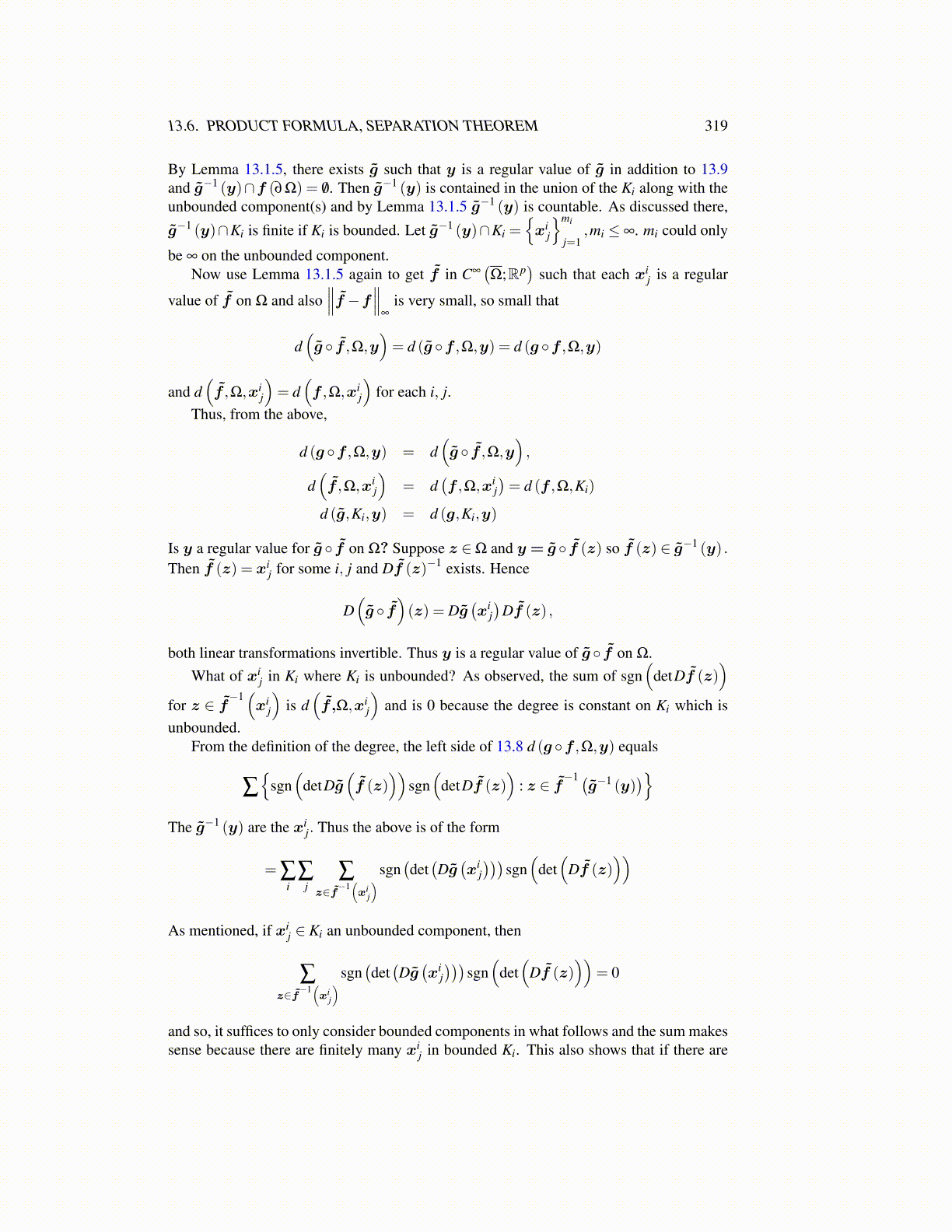
13.6. PRODUCT FORMULA, SEPARATION THEOREM 319
By Lemma 13.1.5, there exists g̃ such that y is a regular value of g̃ in addition to 13.9and g̃−1 (y)∩f (∂Ω) = /0. Then g̃−1 (y) is contained in the union of the Ki along with theunbounded component(s) and by Lemma 13.1.5 g̃−1 (y) is countable. As discussed there,
g̃−1 (y)∩Ki is finite if Ki is bounded. Let g̃−1 (y)∩Ki ={xi
j
}mi
j=1,mi ≤ ∞. mi could only
be ∞ on the unbounded component.Now use Lemma 13.1.5 again to get f̃ in C∞
(Ω;Rp
)such that each xi
j is a regular
value of f̃ on Ω and also∥∥∥f̃ −f
∥∥∥∞
is very small, so small that
d(g̃ ◦ f̃ ,Ω,y
)= d (g̃ ◦f ,Ω,y) = d (g ◦f ,Ω,y)
and d(f̃ ,Ω,xi
j
)= d
(f ,Ω,xi
j
)for each i, j.
Thus, from the above,
d (g ◦f ,Ω,y) = d(g̃ ◦ f̃ ,Ω,y
),
d(f̃ ,Ω,xi
j
)= d
(f ,Ω,xi
j)= d (f ,Ω,Ki)
d (g̃,Ki,y) = d (g,Ki,y)
Is y a regular value for g̃ ◦ f̃ on Ω? Suppose z ∈Ω and y = g̃ ◦ f̃ (z) so f̃ (z) ∈ g̃−1 (y) .
Then f̃ (z) = xij for some i, j and Df̃ (z)−1 exists. Hence
D(g̃ ◦ f̃
)(z) = Dg̃
(xi
j)
Df̃ (z) ,
both linear transformations invertible. Thus y is a regular value of g̃ ◦ f̃ on Ω.What of xi
j in Ki where Ki is unbounded? As observed, the sum of sgn(
detDf̃ (z))
for z ∈ f̃−1(xi
j
)is d
(f̃ ,Ω,xi
j
)and is 0 because the degree is constant on Ki which is
unbounded.From the definition of the degree, the left side of 13.8 d (g ◦f ,Ω,y) equals
∑
{sgn(
detDg̃(f̃ (z)
))sgn(
detDf̃ (z))
: z ∈ f̃−1 (
g̃−1 (y))}
The g̃−1 (y) are the xij. Thus the above is of the form
= ∑i
∑j
∑z∈f̃−1
(xi
j
)sgn(det(Dg̃(xi
j)))
sgn(
det(
Df̃ (z)))
As mentioned, if xij ∈ Ki an unbounded component, then
∑z∈f̃−1
(xi
j
)sgn(det(Dg̃(xi
j)))
sgn(
det(
Df̃ (z)))
= 0
and so, it suffices to only consider bounded components in what follows and the sum makessense because there are finitely many xi
j in bounded Ki. This also shows that if there are